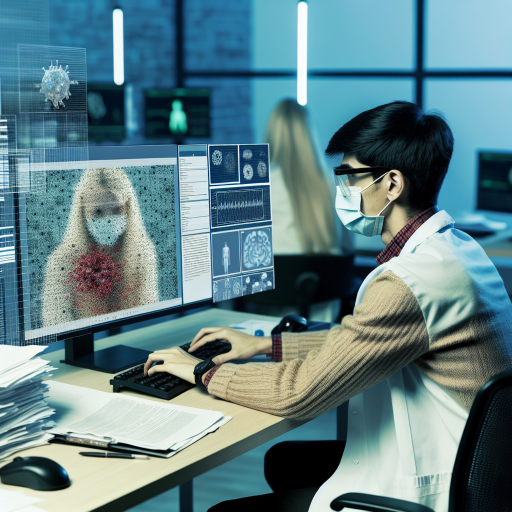Introduction to Epidemiology and its Importance
Epidemiology plays a vital role in public health.
This field studies the distribution and determinants of health-related states.
Furthermore, it focuses on controlling diseases and health problems.
Understanding Epidemiology
Epidemiology examines how diseases spread within populations.
It analyzes patterns, causes, and effects of health conditions.
Through its findings, public health officials make informed decisions.
Public Health Relevance
Epidemiology helps identify health risks in communities.
This identification guides the implementation of preventive measures.
Moreover, it supports the development of public health policies.
Informing Healthcare Decisions
Data gathered by epidemiologists aids healthcare providers.
This data assists in developing targeted interventions for at-risk populations.
Consequently, it improves overall community health outcomes.
Collaborating for Impact
Epidemiologists work with various stakeholders for effective solutions.
They collaborate with governments, healthcare systems, and researchers.
This collective effort enhances the effectiveness of health interventions.
Addressing Emerging Health Threats
Epidemiology is crucial in responding to outbreaks and epidemics.
It tracks emerging diseases in real-time to manage public health risks.
Additionally, epidemiologists contribute to global health security initiatives.
Overview of Tools Used by Epidemiologists
Data Collection Tools
Epidemiologists rely on various data collection tools to gather accurate information.
Surveys often serve as a primary method for collecting health data.
Interviews with individuals provide in-depth insights into health behaviors.
Questionnaires help cover a wide range of health-related topics efficiently.
Additionally, public health databases offer historical health data for analysis.
Statistical Software
Statistical software plays a crucial role in analyzing epidemiological data.
Programs like R and SAS enable epidemiologists to perform complex analyses.
Unlock Your Career Potential
Visualize a clear path to success with our tailored Career Consulting service. Personalized insights in just 1-3 days.
Get StartedThey can explore patterns and relationships in health data effectively.
Moreover, software tools assist in visualizing data for better communication.
Geographic Information Systems
Geographic Information Systems (GIS) are instrumental in epidemiology.
GIS tools visualize the geographical distribution of diseases.
Epidemiologists map outbreaks to identify hotspots for targeted interventions.
Furthermore, GIS aids in understanding environmental factors affecting health.
Laboratory Technologies
Laboratory technologies enhance disease surveillance and diagnosis.
Molecular diagnostics allow for rapid identification of pathogens.
Serological tests provide insights into population immunity levels.
In addition, genomic sequencing helps track the evolution of pathogens.
Modeling Tools
Modeling tools support the prediction of disease spread and impact.
Mathematical models help assess potential intervention strategies.
Simulation models evaluate the effect of different public health policies.
These tools guide public health decisions during outbreaks.
Statistical Software
Analyzing Data with R
R is a powerful programming language for statistical analysis.
It is widely used in epidemiology for its flexibility and capabilities.
Researchers can manipulate and visualize data effectively using R.
Additionally, R offers various packages for specialized analyses.
One popular package is ‘dplyr’, which simplifies data manipulation.
Another useful package is ‘ggplot2’, which creates detailed graphs.
Moreover, R can handle large datasets efficiently.
Many epidemiologists appreciate R for its active community support.
They have access to numerous online resources and forums.
Furthermore, R is free and open-source, promoting inclusivity.
Exploring Data with SAS
SAS is another leading software for statistical analysis.
It is well-known for its reliability and speed in handling data.
Many organizations use SAS for complex statistical procedures.
The software excels in data management and manipulation as well.
With SAS, users can access advanced analytics tools easily.
It also provides a user-friendly interface for beginners.
Additionally, it has thorough documentation for guidance.
Organizations often utilize SAS for regulatory compliance.
It is popular in clinical trials and public health studies.
Overall, both R and SAS play significant roles in epidemiological research.
Choosing the Right Software
Choosing between R and SAS often depends on specific needs.
Some prefer R for its cost-effectiveness and flexibility.
In contrast, others may opt for SAS due to its robustness.
Evaluating the study’s requirements is crucial before deciding.
Each software has unique strengths that can benefit researchers.
Ultimately, the choice will impact the speed and accuracy of analysis.
Explore Further: Impact of Epidemiologists on Healthcare Systems
Geographic Information Systems (GIS) in Epidemiology
Understanding GIS Technology
Geographic Information Systems (GIS) revolutionize how epidemiologists analyze data.
This technology allows the visualization of health data across different geographic locations.
Moreover, GIS enhances spatial analysis for disease outbreak tracking.
Application of GIS in Disease Surveillance
GIS plays a crucial role in monitoring disease patterns.
It helps in identifying hotspots for disease outbreaks.
Additionally, GIS aids in predicting the spread of infectious diseases.
Epidemiologists visualize the distribution of diseases across populations effectively.
Benefits of GIS in Epidemiology
One significant benefit is improved decision-making capabilities.
GIS offers real-time data analysis for public health officials.
Consequently, it helps optimize resource allocation during health emergencies.
Challenges in Using GIS
Despite its advantages, GIS presents challenges.
Data privacy concerns arise when using personal health data.
Moreover, the accuracy of data can be a significant issue in analysis.
Finally, the cost of GIS software can limit accessibility for some organizations.
Future of GIS in Epidemiology
The future of GIS looks promising in the field of epidemiology.
Emerging technologies, such as artificial intelligence, will enhance GIS capabilities.
Furthermore, integrating social media data may provide additional insights.
GIS will continue to evolve and shape epidemiological research.
Delve into the Subject: Exploring Geologist Job Opportunities in Canada
Data Collection Tools: Surveys and Questionnaires
Surveys as a Primary Tool
Surveys are essential for collecting data from populations.
They provide structured methods to gather responses.
Furthermore, surveys can reach large audiences quickly.
Researchers tailor survey questions to specific targets.
This ensures relevance and accuracy in data collection.
Types of Survey Methods
Various methods exist for conducting surveys effectively.
Online surveys are increasingly popular for their convenience.
Face-to-face interviews yield detailed qualitative data.
Telephone surveys allow researchers to reach diverse populations.
Mail surveys offer a traditional approach that remains relevant.
Questionnaires: Designing Effective Tools
Questionnaires form the backbone of many survey methodologies.
Well-designed questionnaires enhance response rates significantly.
Open-ended questions encourage detailed and qualitative feedback.
Closed-ended questions provide quantifiable data for analysis.
Clarity in wording is crucial to avoid misunderstandings.
Utilizing Technology for Surveys
Technology simplifies the survey distribution process.
Digital platforms facilitate real-time data collection.
Tools like Google Forms streamline questionnaire creation.
SurveyMonkey offers features for analysis and reporting.
These technologies improve the efficiency of data analysis.
Importance of Data Privacy
Data privacy is paramount in survey research.
Researchers must ensure participant anonymity and confidentiality.
Ethical considerations guide the data collection process.
Compliance with regulations like GDPR is essential.
This builds trust between researchers and participants.
Uncover the Details: Epidemiology and Its Role in Public Health Crises
Bioinformatics Tools for Epidemiological Research
Importance of Bioinformatics
Bioinformatics plays a crucial role in modern epidemiology.
It enables researchers to analyze complex biological data.
Moreover, it helps in understanding disease patterns and transmission.
Data Analysis Tools
A variety of software applications assist in data analysis.
Among the popular tools are R and Python.
R provides statistical capabilities while Python supports extensive data manipulation.
Additionally, tools like BioConductor enhance R’s capabilities.
Genomic Sequencing Tools
Genomic data is pivotal in studying infectious diseases.
Tools such as GATK and SAMtools facilitate efficient genomic analysis.
They allow for variant calling and genome assembly, respectively.
Visualization Software
Visualization tools enhance data interpretation.
Software like Tableau and ggplot2 enables clear representation of complex data.
These tools aid in identifying trends and anomalies in epidemiological data.
Database Management Systems
Databases store vast amounts of epidemiological data.
MySQL and PostgreSQL are commonly used systems for managing data.
They support structured queries and large data sets efficiently.
Public Health Databases
Several public health databases are available for researchers.
Examples include the CDC Wonder and WHO databases.
These provide crucial health statistics and disease surveillance data.
Modeling and Simulation Tools
Mathematical modeling is essential for understanding disease dynamics.
Tools like LSTML and EpiModel help simulate disease spread.
These allow researchers to predict outbreaks and evaluate interventions.
Statistical Modeling
Statistical models assess the effectiveness of public health measures.
Software like SAS and STATA provide advanced statistical analysis options.
They support hypothesis testing and regression analysis.
Collaborative Platforms
Collaboration enhances the scope of epidemiological research.
Platforms like GitHub and Google Drive facilitate data sharing and project management.
These tools promote teamwork among researchers globally.
You Might Also Like: Canadian Universities Offering Geology Programs

Modeling and Simulation Software: Predicting Disease Spread
Importance of Predictive Modeling
Predictive modeling plays a crucial role in epidemiology.
This technology helps forecast disease outbreaks effectively.
Epidemiologists rely on software to simulate various scenarios.
Such simulations provide valuable insights into transmission dynamics.
Commonly Used Software Packages
Several software packages are widely used by epidemiologists.
Among them, GLEaMviz stands out for its advanced capabilities.
Another popular choice is Epi Model, which focuses on network dynamics.
These tools enable users to model complex epidemiological scenarios.
GLEaMviz
GLEaMviz effectively integrates disease spread models with mobility data.
This software allows researchers to visualize epidemic patterns.
It combines human mobility and population data for accurate predictions.
Epi Model
Epi Model specializes in agent-based modeling.
This software allows for simulating disease transmission within populations.
Users can adjust parameters to reflect real-world conditions.
Applications of Modeling Software
Modeling software has various applications in public health.
It helps evaluate intervention strategies before implementation.
Moreover, it aids in resource allocation during outbreaks.
Ultimately, these tools support decision-making processes for health authorities.
Challenges in Predictive Modeling
Despite their advantages, predictive models face challenges.
Data quality for inputs often varies significantly.
Additionally, unforeseen variables can affect model accuracy.
Yet, continuous advancements in software aim to address these issues.
Future Trends in Epidemiological Modeling
The field of epidemiological modeling is evolving rapidly.
Future software will likely incorporate artificial intelligence.
AI can enhance pattern recognition and predictive accuracy.
Ultimately, these advancements will further empower epidemiologists.
Emerging Technologies: Wearables and Mobile Health Applications
Introduction to Wearables
Wearable technology is transforming how epidemiologists gather data.
These devices capture vital signs, activity levels, and health metrics.
Wearables provide valuable insight into population health trends.
Types of Wearable Devices
Common types of wearables include fitness trackers and smartwatches.
These devices can monitor heart rate, sleep patterns, and physical activity.
Moreover, they collect data in real-time, enhancing research accuracy.
Mobile Health Applications
Mobile health apps play a critical role in epidemiology.
They allow individuals to track their health and report symptoms.
These apps simplify data collection through user engagement.
Key Features of Mobile Health Apps
Many apps offer symptom checkers and health risk assessments.
They also provide educational resources to promote wellness.
Furthermore, these applications can alert users to potential health issues.
Data Sharing and Privacy Concerns
Wearables and mobile apps generate vast amounts of data.
It is crucial to address privacy concerns regarding personal health information.
Users should be informed about data usage and sharing policies.
Future of Wearables and Mobile Health Technologies
The future of wearables looks promising in epidemiology.
Advancements in technology will enhance data accuracy and usability.
Ultimately, these tools will provide deeper insights into public health.
Importance of Collaboration Tools in Epidemiological Studies
Enhancing Communication
Effective communication among team members is crucial in epidemiological studies.
Collaboration tools streamline this process, allowing for real-time discussions.
Additionally, these tools help in sharing important findings quickly.
Consequently, research teams can make informed decisions promptly.
Facilitating Data Sharing
Data sharing is vital for successful epidemiological research.
Collaboration tools simplify the process of sharing large datasets.
While using cloud-based systems, researchers can access data anytime, anywhere.
This accessibility enhances collaboration across different geographical locations.
Improving Project Management
Managing projects effectively is essential in achieving research goals.
Collaboration tools provide leadership with tools to assign tasks efficiently.
Moreover, these tools help track project progress and deadlines.
This organization reduces the risk of delays in research timelines.
Encouraging Multi-Disciplinary Cooperation
Epidemiological studies often require expertise from various fields.
Collaboration tools foster interaction among epidemiologists, statisticians, and public health officials.
This multi-disciplinary approach enriches the research process.
Furthermore, diverse perspectives lead to innovative solutions.
Building Trust and Team Cohesion
Trust is a fundamental element in collaborative research settings.
Using collaboration tools helps build transparency among team members.
When everyone has access to the same information, trust grows naturally.
Also, improved communication fosters a sense of belonging within the team.
Supporting Remote Research Activities
The recent global pandemic emphasized the need for remote collaboration.
Collaboration tools enable uninterrupted research, even in remote settings.
This flexibility allows epidemiologists to adjust to changing circumstances quickly.
Ultimately, it expands opportunities for research without geographical constraints.
Significance of Collaboration Tools
Collaboration tools are essential in modern epidemiological research.
They improve communication, data sharing, and project management.
Furthermore, they encourage cooperation and trust among team members.
As a result, these tools significantly contribute to the overall success of studies.
The Future of Tools and Technologies in Epidemiology
Increased Data Collection Capabilities
The future of epidemiology relies heavily on enhanced data collection methods.
Wearable technology will become more ubiquitous.
This advancement allows continuous health monitoring for various populations.
Furthermore, mobile health applications will provide real-time data collection.
Consequently, epidemiologists will access larger, diverse datasets.
Integration of Artificial Intelligence
Artificial intelligence will play a pivotal role in future epidemiological studies.
This technology enables quicker data analysis and pattern recognition.
Machine learning algorithms will predict disease outbreaks with increased accuracy.
As a result, public health officials can respond proactively to emerging threats.
Enhanced Visualization Tools
Future tools will include advanced data visualization techniques.
These tools will illustrate complex epidemiological data effectively.
User-friendly interfaces will improve accessibility for non-specialists.
Moreover, interactive maps will showcase epidemiological trends in real time.
Collaboration Across Scientific Disciplines
Collaboration will become essential in epidemiology’s future landscape.
Partnerships with tech companies will drive innovation and development.
Additionally, interdisciplinary teams will tackle complex health issues together.
Such collaboration will enhance research quality and efficiency.
Greater Emphasis on Public Engagement
The future will also focus on public engagement in epidemiology.
Community participation will shape data collection methodologies.
Educating the public about health risks will foster better health behaviors.
Consequently, increased public awareness will improve health outcomes.
Additional Resources
Translating research findings to clinical nursing practice – PMC




